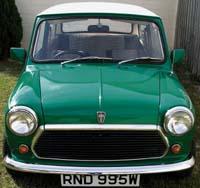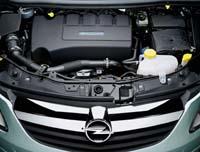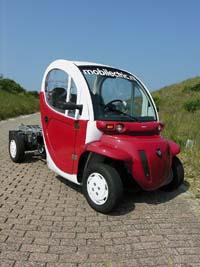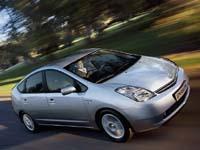Cars in green

Perhaps the name is not very original, but yes the car. The competition includes innovation, intelligent design, appearance, originality, quality, design for production and maintenance, ergonomics, safety, as well as its environmental impact. The Globetrotter is a good car in all aspects, but stands out especially for its impact on the environment.
Most components of the car are biodegradable. In fact, the main material used in the manufacture of the car is a polymer, with 12% oil and 88% corn, very light. It gets the energy needed to move through a fuel cell and the paint it covers uses nanotechnology when it is stationed to absorb solar energy, charging batteries.
But it is not yet on the street. It is expected to launch in 2017. However, it is a clear example to see in which direction the cars are moving. It seems that more and more are being tried to design cars that cause the least damage to the environment, and to a large extent are driven by legislation.

New rules of procedure
The European Commission has recognized that by 2012 cars sold in the European Union will not be able to emit more than 120 grams of carbon dioxide per kilometer into the atmosphere. Therefore, motorists have no choice but to advance in the reduction of current emissions, but they will receive a fine.
Even before that date, governments have begun to take action. For example, at the beginning of the year, the Spanish government launched a new law on the registration tax. Before the tax was established according to the measurement of the engine, but now the owner must pay according to the carbon dioxide emitted by the car. In addition, cars that emit less than 120 grams of carbon dioxide per kilometer will not have to pay registration taxes.
In Germany, protected areas of traffic pollution have been created in three cities: Berlin, Cologne and Hannover. Drivers must carry a sticker in the car to access these urban areas. The amount of contaminating particles emitted by the car must carry a green, yellow or red adhesive, and the price of the adhesive will depend on it. The Municipal Guard sanctions motorists who enter without a queue, but say that most drivers buy it.

The French and Italian motorists, for their part, managed to reduce carbon dioxide emissions last year. In fact, the French company PSA Peugeot Citröen, the second largest European producer, sold the least polluting cars. According to data from the company, last year it sold about one million cars that emitted less than 140 grams of carbon dioxide per kilometer, of which 450,000 are less than 120 grams and 200,000 cars do not reach 110 grams. It is clear that some cars will reach easier than others to the target set for 2012.
More than one key
The cars not only affect the environment in their use; from the materials that are selected for their manufacture to their arrival in the street, the risk of involvement to the environment is every step, even when it is aged and rejected. However, the biggest impact occurs in the use of the car.

To reduce this impact there is no single key, we must take care of some aspects. One of them is the engine. Most cars have engines that burn gasoline or diesel. These are fossil fuels that generate a lot of pollutants, both in their passage through underground natural deposits to access the tanks of the cars and in their burning. In order to reduce fuel use, motorists have increased the efficiency of engines, improved combustion, and used filters to trap contaminating particles.
On the other hand, fossil fuels can be replaced by biofuels, such as biodiesel and bioethanol. They are renewable energy sources, so their use reduces the dependence of fossil fuels. In addition, they are of vegetable origin and, to some extent, the carbon dioxide that is generated in the rivers is equal to that which they have absorbed in the first plant. However, some experts doubt the veracity of biofuels, since some studies have shown that, taking into account the whole process, they are not as favorable to the environment as expected.
Regardless of the biofuel production process, the use of biodiesel does not require changes in the engine, but can be used in any diesel engine. Bioethanol, on the other hand, can be used mixed with gasoline, in small proportion without changes in the engine (5-10% bioethanol) and in greater proportion in specially prepared engines.
Precisely for this purpose, manufacturers have created flexible vehicles (FFV, flexi-fuel vehicles). These cars are prepared to move with the largest mixture of bioethanol (E85, which accounts for 85% of fuel) and conventional gasoline.

Other technologies
The cars have adopted other ways to reduce carbon dioxide emissions, with which already exist in the market electric and hybrid cars. Electric cars do not emit gases and are completely silent, so they present remarkable advantages over others. However, they have disadvantages: the batteries are recharged plugged into the electric grid - and for this time is required -, they do not have too much autonomy and do not reach high speeds. For all this, they are suitable for urban trips but not for long trips.
In addition, they are quite expensive and most consumers are not willing to pay so much. On the other hand, it must be taken into account that electric cars do not directly emit polluting gases into the atmosphere, but the electricity needed to charge the batteries comes from power stations - and although some use renewable energy sources, many others do not -. However, since last year is on sale the first electric car on the market in Spain, Reva, while in France they are more extended, but they are not very common either.

There are other vehicles that, without being totally electric, take advantage of their advantages, are hybrid cars. There are several types and the first level of hybridization is Stop Start technology. The car engine with this technology stops when the car's speed drops by 6 kilometers per hour and is distributed when the driver raises the foot of the brake pedal.
This technology is very useful on trips inside the city, as it stops a lot the car and gets underway immediately. This allows to save between 8 and 15% of fuel, reducing pollution by both carbon dioxide and acoustics. Many cars already have Stop Start technology.
The next level is to have a secondary electric motor to support the combustion engine. This engine allows to recover the braking energy and obtain an additional power at the necessary moments. This means a saving of 15% in fuel.
Finally, there are totally hybrid cars. They have two engines, one of combustion and another electric of the same power. These cars do not need to be plugged into the electric grid as the batteries are charged with the energy that is left over when lowering the slopes or braking. In addition, they have an electricity generator to transform the energy that is not sent to the wheels from the combustion engine into electricity. You can use this electricity to supply the electric motor or charge the battery.

One of the best known hybrid cars is the Toyota Prius. He went on the market in 1997 and in 2005 received the European prize for the best car. Currently, 90% of hybrid cars come from this model. According to them, the car can travel 100 kilometers with a gasoline of 4.3 liters, that is, a hybrid car needs 40% less gasoline than a vehicle of its same weight and size with a gasoline engine of similar power.
Looking to the future
The evolution of the engines has not stagnated and is being investigated with the aim of developing technologies that allow the use of cleaner, cheaper and efficient fuels. The fuel cells are quite advanced, for example.

The fuel cells, through an electrochemical process, directly transform the chemical energy contained in the fuel into electricity and heat and do not release contaminants. Regarding the batteries, they are never exhausted, since they do not contain reagents inside. Therefore, they must be fed from outside. The reaction requires an oxidizer and a fuel; the most common oxidizers are oxygen from the air or pure oxygen and the most used fuel is hydrogen.
However, there is still much to be investigated. Hydrogen can be obtained from many sources, but for this purpose a new source of energy is necessary, so its impact on the environment is greater or smaller depending on the system of obtaining hydrogen. The storage is not easy, not even for cars, and for the moment the cars powered by hydrogen are very expensive.
Even more distant alternatives than fuel cells are vehicles based on other types of energy, such as solar. There are prototypes and also run races with the aim of promoting this technology, but it will take a long time to see this type of cars on the street if they are marketed.
Today for today

It is clear that, although the cars are dressed in green, the vehicles less harmful to the environment are the feet. Therefore, it would be best not to have to use the car, but the changes necessary for it are of another level. Meanwhile, motorists will continue to try to make the car environmentally sustainable.






